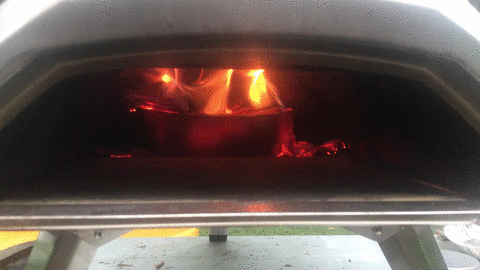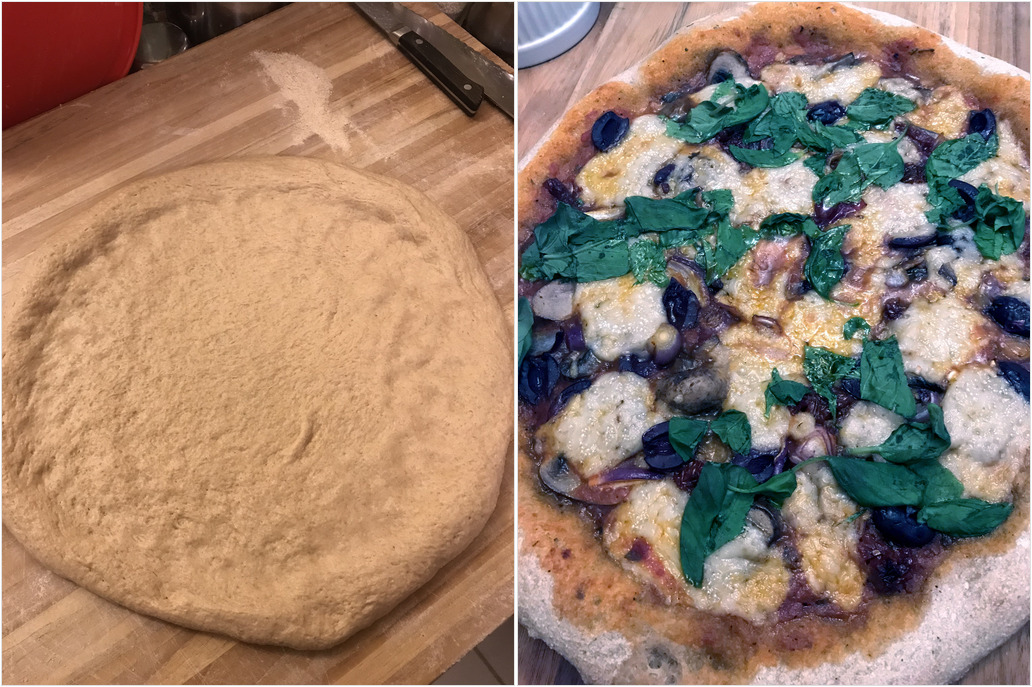
This summer, while social distancing in our cabin, I purchased a small wood fired pizza oven where I practiced applying my sourdough starter to making sourdough pizza. At temperatures between 900F and 1000F (the later being "Hi" or my IR gun) the challenge is to continuously rotate the pizza to keep things from burning while ensuring the top and bottom cook evenly in 1 or 2 minutes. In addition, chopping lots of tiny hardwood pieces of the precise size needed to keep the little firebox roaring adds to the list of chores. Our felled locust burns very hot and works exceptionally well for this.
I was missing the sourdough pizza from the Summer and have also been missing the excellent Neopolitan style pizzas from several nearby restaurants (Motorino, Robertas, etc) due to pandemic driven isolation now that we are back in our little Brooklyn apartment. Inspired by recent TFL posts on home oven pizza, and after recently acquiring an oven stone to support the task, I leafed through some whole grain focused pizza recipes in Adam Leonti's Flour Lab and settled on the Pizza Napoletana [1] .
The recipe calls for a soft spring wheat flour (Frederick preferred). I went with a Palouse Soft Spring Wheat (unknown variety) that would arrive in time for milling and baking on New Years Eve, but am interested in sourcing some of the recommended Frederick for a follow up. He indicates his preferred wheat variety for each recipe. In this case he explains:
I used Frederick soft spring wheat flour because it maintains that signature white hue, mild flavor, and soft crumb that is synonymous with Naples's most famous food.
The recipe is a basic 63% hydration dough:
- 630 g water
- 1000 g soft spring wheat flour
- 14 grams sea salt
- 2 grams active dry yeast (I used a chunk of Desem starter)
- Neutral oil for greasing
- Desired topping
I wanted to experiment with my cool low hydration Desem starter, which I substituted for the ADY. I milled the soft white wheat coarse-to-fine and then made a soaker (saltolyse) which sat in the fridge for a couple of days to improve extensibility. The dough felt far too dry at 63% hydration with this wheat (noticeable cracks and fraying) so I ended up increasing the hydration significantly after warming it up and mixing in a chunk of refrigerated Desem starter prior to bulk fermentation.
To add to the list of accumulating violations, this was destined to be a plant based pizza (i.e., no mozzarella). I sourced a plant based cheese that melts reasonably well, tastes good, and doesn't resemble a rubbery polymer based lab creation upon melting: Miyoko's organic cultured vegan mozzarella. On a related note, I sampled a fermented tofu at a Japanese restaurant in the Lowesr East side last year that was one of my notable culinary memories of 2020. I think it would work swimmingly in this context, but I have yet to find a local source for it. The process is described well in online videos, so it may be another one for the home fermentation lab.
I waited for some signs of fermentation and reasonable gluten development given the low protein flour, then shaped it carefully with the backs of my hands before finishing the slightly fragile dough into a pizza with raised crust using the tips of my fingers, taking care to de-gass the center portion before adding toppings. The oven stone was approximately 525F. After 5 minutes or so I added the fresh basil (at 500F the pizza cooks too slowly and the basil would otherwise dry out) and then cooked for another 2 minutes or so before removing it.
The flavor of the crust was excellent (beyond my expectation at least), with a mild tender sweetness and suppressed but still noticeable tang. It did rise pretty well for the whole grain flour, but the biggest mark against the pizza was the crust color, which was unfortunately pale and somewhat lifeless, which was a real shame. From recent discussions, I believe this is related to cooking uncovered in a gas oven. I always use a wide clay cloche for my hearth bread bakes, and have not had success with open stone bakes and improved steam. Perhaps something akin to a cloche is needed to trigger a maillard reaction. Following older TFL posts on the subject, I may experiment with an inverted Graniteware roaster placed on top of the baking stone, or a "disposable" aluminum alternative.
Another consideration is the lack of top heat in the home oven. When the mini wood fired pizza is roaring, the chimney draws the flames from the rear firebox along the low ceiling over the top of the pizza and up and out the chimney. That is helpful for matching the heat pizza stone underneath and providing the signature char.

In our gas home oven there is no top heat source, but there is a broiler that could serve this purpose. Next time I'm inclined to bake 1/2 way through covered on the stone, then remove and place under the broiler with a turning peel to add a hint of charring to the top crust. It is worth a shot and would add the main missing element to the final product.
Any thoughts on this issue are appreciated.
[1] baking 400 F degrees short of the 932 F target using home milled whole grains would clearly cause some concern in the Associazione Vera Pizza Napoletana (AVPN), so this is really an "inspired by" translation. In the words of Stevie Wonder "Ya gots to work with what you gots to work with."

- headupinclouds's Blog
- Log in or register to post comments
Would the cornstarch glaze trick work on pizza cornicione? Or even brushing on plain water?
That's a good thought. I like the water approach or perhaps a very thin glaze to reduce major discontinuities. I recently read about baker Florian Domberger's seele loaf, which he dunks in water before baking to develop the crust style he is after (after a fair amount of practice). I think the same could be applied in this case. Perhaps I could spray the entire pizza before baking. Both Gerhard and The Roadside Pi both suggest longer bake times will be needed in a related thread on pale baguettes, and the additional water might actually help with crust and prevent drying out with the longer bake times. Come to think of it, pushing hydration further in the dough itself might also help, but I had already gone well above the specified 63% hydration. If the hydration is too high it can be a challenge to unload from the peele, even with ample semolina. In the home oven case the temperature is low enough that I can always rely on parchment paper.
I think you'd have better color if the soaker spent more time at room temp.
Another good thought. Additionally, pizza dough may be a case where a traditional autolyse (sans salt) would be advantageous to develop extensibility, whereas I've been shifting towards salt in whole grain hearth loaf baking specifically to fight proteolysis and support tighter shaping.
Peter Reinhart in Whole Grain Breads [p 267] (whole grains + instant yeast):
Jeffrey Hammelman Bread [p 344] (bread flour + instant yeast):
The Leonti recipe also calls for a 36 hour bulk fermentation using ADY. Since I'm using a sourdough starter, I don't think the dough will hold up for 36 hours, but it will certainly be fine overnight. I can also use a larger PPF via the Desem starter, which holds up pretty well due to the low temperature. Hammelman's comment about "enough moisture" makes me want to try further increasing hydration in the initial mix (> 75% or so) with additional water by feel to protect the crust in these longer bakes. This flour must be much thirstier than the Frederick he was using.
Broiling will help give it some color for sure. You should also heat up your baking stone by using the broil feature before you put the pizza in the oven. Brush the crust with olive oil if you are not already doing it which will help as well.